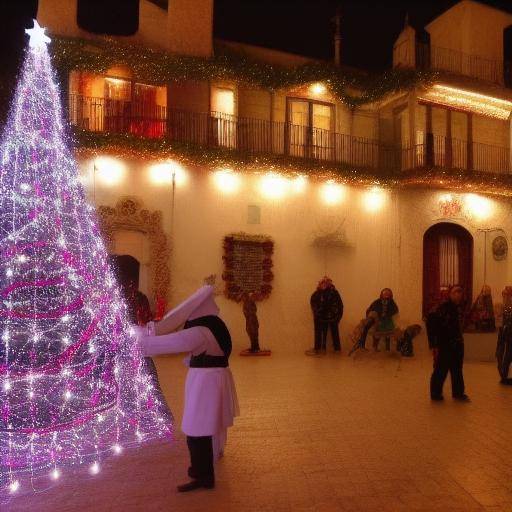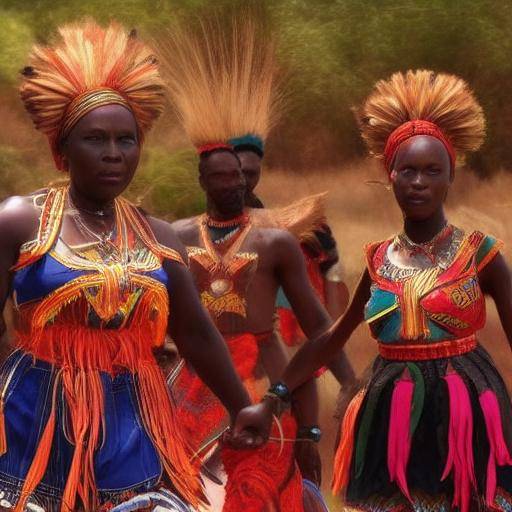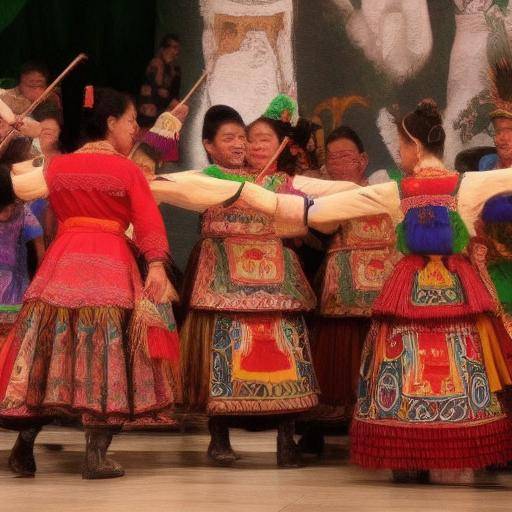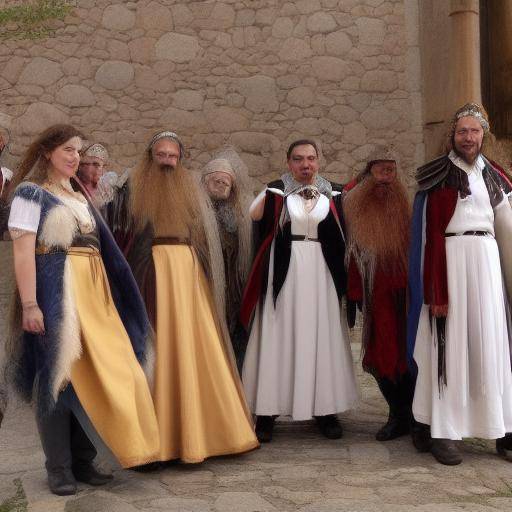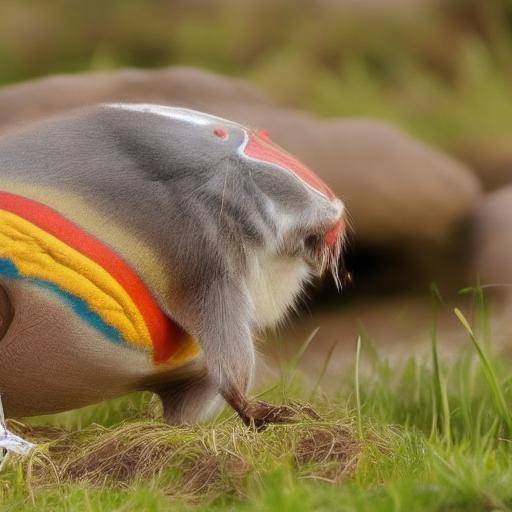
Cultural wealth and the connection with nature are fundamental elements in South American traditions. The myths of nature, rooted in South American folklore, offer a fascinating view of the relationship between humanity and its natural environment. In this article, we will explore in depth the myths of nature in the context of South American folklore, unraveling its meanings, its history, and its influence in today's society. Immerse yourself in the legends that have endured over time and discover how these mythical accounts continue to be relevant in modernity.
Introduction
The myths of nature in South American folklore are not only fascinating stories, but also represent the intersection between culture, history and nature. Over the centuries, these narratives have transmitted ancestral wisdom, cultural values and a deep connection with the natural environment. In this article, we will explore the wealth of these traditions and their impact on contemporary society.
History and Background
The myths of nature in South America have deep roots that go back to pre-Columbian civilizations. Civilizations such as the Incas, Mayas, Aztecs, and many others, developed complex beliefs about nature and its phenomena, which was reflected in their myths and legends. These stories conveyed teachings about the importance of caring for the earth, respecting its cycles and living in harmony with the natural environment.
Over the centuries, the arrival of European conquerors and colonization modified and enriched these traditions, merging indigenous beliefs with the cultural influences brought from Europe. This cultural mestizaje gave rise to a great diversity of nature myths that continue to be transmitted from generation to generation in South America.
Nature Myths in the South American Folklore
The Jungle Guardians
In the dense Amazon rainforests, stories are told about mystical beings that protect flora and fauna. These guardians, whose forms may vary from large felines to elemental spirits, warn the intruders about the danger of disrupting natural balance. Often, these myths serve as a warning to respect and preserve the biodiversity of the Amazon rainforest.
The Holy Mountains
In the Andes, the imposing mountains are considered sacred and inhabited by powerful divinities. The myths associated with these mountains tell stories of sacrifices, spiritual teachings and the importance of honoring the earth. These legends have deeply influenced the Andean worldview, promoting respect for nature and the recognition of its sacred character.
Spirits of the Water and the Wind
In the coastal regions, the stories of spirits linked to water and wind are recurrent. From aquatic sirens to the gods of the wind, these narratives highlight the veneration for the natural elements and the dependence of humanity on these resources. Water and wind myths also have lessons on ecological balance and the importance of taking care of marine and coastal ecosystems.
The Sun and the Moon
Duality between the sun and the moon is a recurring theme in South American folklore. These stars are personified in stories that explore their relationship with earth, the cycle of life and the influence on harvests and seasons. These myths also address the importance of respecting the natural order of the universe and living in harmony with the lunar and solar cycles.
Deep analysis
Actual Cultural Relevance
Although the myths of nature in South American folklore come from ancient times, their cultural relevance persists in today's society is undeniable. These narratives continue to influence the way in which South American communities perceive and relate to their natural environment. From the conservation of biodiversity to the promotion of sustainable practices, nature myths remain a source of inspiration to preserve ecological balance and promote respect for land and its resources.
Preservation of Cultural Heritage
The myths of nature in South American folklore represent an essential component of the cultural heritage of the region. Its preservation and dissemination are fundamental to the preservation of local identity and traditions. Through festivals, ceremonies and community activities, the aim is to keep alive the narrative of these mythological stories, thereby strengthening the sense of belonging and cultural heritage in the new generations.
Educational approach
In the educational field, nature myths offer a valuable opportunity to teach about the history, ecology and cultural diversity of South America. By integrating these stories into school curricula, a deeper understanding of the interaction between humanity and nature is encouraged. In addition, critical awareness of the importance of preserving the environment and respecting the beliefs and traditions of indigenous communities is encouraged.
Comprehensive review
Diversity of Interpretations
The richness of the myths of nature lies in its ability to be interpreted in various ways. While some communities can see in these stories a lesson on the importance of environmental conservation, others can find in them a spiritual guide to live in harmony with nature. The diversity of interpretations enriches the significance of these myths and ensures their durability over time.
Persistence in Popular Culture
Despite social changes and transformations, nature myths continue to be an integral part of popular culture in South America. These narratives have transcended generations and remain alive through artistic expressions such as literature, music, dance and handicrafts. Even in the digital era, these stories find ways to adapt and spread, thus maintaining their influence in contemporary society.
myths and technology
Modern technology has opened new ways of narrating and transmitting the myths of nature. Through video games, movies and digital platforms, the scope of these stories has been amplified, reaching wider and diversified audiences. This phenomenon demonstrates the ability of nature's myths to adapt to cultural changes and remain relevant in a constantly evolving world.
Comparative analysis
Regional similarities
Despite cultural differences among the various South American peoples, the myths of nature share remarkable similarities. Reverence to land, the embodiment of natural elements and the oral transmission of these stories are common elements that transcend geographical boundaries. This mythological cohesion enriches the cultural identity of the region and strengthens the links between communities.
Diversity of Approaches
As we explore the different myths of nature in South America, we can appreciate the diversity of approaches and themes present in these narratives. While some legends focus on the protection of the jungle, others emphasize respect for mountains, water or wind. This thematic variety reflects the multiplicity of natural environments present in South America and the richness of the cultural traditions surrounding them.
Intercultural Influences
The influence of indigenous, European and African cultures in South America is manifested in the diversity of myths of nature. Through the interaction between these cultures, different beliefs and practices have been intertwined, leading to an amalgam of myths and legends that reflect the complexity and cultural wealth of the region. This combination of influences has enriched South American folklore, generating a diversity of nature myths that persist in the collective imagination.
Practical Tips and Accessible Tips
Promoting Conscientization
- Participates in community activities that promote the conservation and protection of nature.
- Write stories or poetry inspired by the myths of nature to spread your message.
- Research and visit relevant natural spaces to better understand the context of myths.
- It supports local artists who dedicate themselves to the creation of works inspired by nature myths.
Preservation of Folklore
- It documents and orally preserves the myths of nature transmitted by ancestors or members of the community.
- Participate in cultural festivals and events that spread the myths of nature.
- It collaborates with organizations working on the preservation of cultural and mythological heritage.
- Encourage new generations to keep the myths of nature alive through narration, music or art.
Education and awareness-raising
- It integrates the myths of nature into the educational curriculum and promotes its teaching in schools.
- It organizes lectures or conferences on the cultural and environmental importance of nature myths.
- It develops environmental education programs that incorporate the wisdom present in mythological accounts.
- It collaborates with libraries and cultural centers to disseminate literature and educational material related to the myths of nature.
Contributions of the Industry and Opinions of Experts
Scientific Outlook
According to anthropologist Dr. Juan Martínez, the myths of nature offer a unique window to understand the beliefs and the worldview of South American cultures. Martínez emphasizes that these accounts contain empirical knowledge about the natural environment, which are valuable for the conservation of biodiversity and the promotion of sustainable practices.
Art and Literature Contributions
The writer and folklorist Diana Montalvo highlights the role of art and literature in preserving the myths of nature. Montalvo points out that through artistic expression, it is possible to keep alive the essence of these narratives, transmitting their symbolic power and timeless message to the new generations.
Impact on Sustainable Tourism
In the words of environmentalist María Fernández, the myths of nature play a relevant role in the development of sustainable tourism in South America. Fernández emphasizes that understanding and respect for these narratives can foster conscious and responsible tourism, which values and protects the natural ecosystems described in myths.
Case Studies and Real Life Applications
Resurgence of Ancestral Traditions
In the Quechua indigenous community in Peru, a resurgence of nature myths has been observed as a way of reaffirming cultural identity and promoting the conservation of the natural environment. Through festivals and ceremonies, the members of this community have revitalized ancient practices related to the veneration of land and natural elements.
Environmental education in Uruguay
In Uruguay, an educational program has been implemented that integrates the myths of nature as a tool to raise awareness among students about the importance of environmental preservation. Through the narrative of mythical accounts, young people learn not only about the cultural history of their region, but also about the need to protect natural resources.
Visual Art and Narration in Argentina
In the province of Jujuy, Argentina, local artists have used the myths of nature as a source of inspiration to create murals and works of art that highlight the beauty and importance of nature in the region. These artistic expressions not only embellish communities, but also serve as a visual reminder of the importance of preserving the land and its natural resources.
Future Trends and Predictions
Digitization of Nature Myths
Digitalization and the use of online platforms are expected to continue to play a crucial role in the dissemination and preservation of nature myths. Creating digital content, such as podcasts, educational videos and interactive applications, will allow these stories to reach wider audiences, thus preserving their legacy for future generations.
Interdisciplinary collaborations
There is a greater interest in collaboration between experts in folklore, ecology, anthropology and education to deepen understanding of the myths of nature. This integration of disciplinary perspectives will ensure that myths are appreciated in their cultural and ecological context, and that their teachings are effectively applied in society.
Innovation in Narration and Art
An increase in narrative and artistic innovation is expected to focus on the myths of nature. The combination of traditional techniques with contemporary media, such as digital animation and virtual reality, will open up new possibilities to present and convey these stories in an impactful and meaningful way.
Conclusion
The myths of nature in South American folklore are treasures of wisdom, beauty and cultural significance. These narratives not only reflect the deep connection between the South American communities and their natural environment, but also provide timeless lessons on the importance of protecting and preserving the land. As we enter the world of the myths of nature, we discover the wealth of South American cultural heritage and inspire ourselves to honor and value the nature that surrounds us.
Frequently asked questions
What is the purpose of the myths of nature in South American folklore?
The myths of nature fulfill multiple purposes, including the transmission of knowledge about the natural environment, the promotion of cultural values and the preservation of ancestral heritage. These narratives also foster a deeper connection with the land and its resources, thus promoting its conservation.
How have the myths of nature evolved over time?
The myths of nature have evolved through interaction and cultural mestizaje, integrating indigenous, European and African influences. As South American societies have changed, these accounts have adapted their themes and approaches to remain relevant in contemporary culture.
What role do nature myths play in environmental conservation?
Nature myths serve as a reminder of the importance of preserving ecological balance and respecting biodiversity. These narratives promote a deeper understanding of the interaction between humanity and nature, thus fostering attitudes and actions aimed at environmental conservation.
How are nature myths used in education?
In educational contexts, nature myths are used to teach about history, ecology, cultural diversity and the importance of preserving the environment. Through the narrative of mythological accounts, a deeper understanding of the relationship between humanity and nature is encouraged.
What is the importance of preserving the myths of nature in South American folklore?
The preservation of the myths of nature in South American folklore is crucial for preserving cultural heritage, promoting the cultural identity of communities and transmitting teachings on the relationship between humanity and nature. These narratives represent a valuable heritage that deserves to be protected and shared with future generations.
How do myths of nature relate to the South American worldview?
The myths of nature reflect the South American worldview by emphasizing the interconnection between humanity, earth and other living beings. These narratives show respect and veneration for nature, as well as the understanding that harmony with the environment is fundamental to human well-being and the balance of the universe.
Concluding, the myths of nature in South American folklore enclose a treasure of ancestral wisdom, narrative beauty and cultural significance. Its influence persists in modern society, promoting environmental conservation, enriching cultural identity and serving as inspiration for respect for nature. These mythological accounts are a powerful expression of the profound connection between humanity and its natural environment, and deserve to be appreciated and preserved for generations to come.


